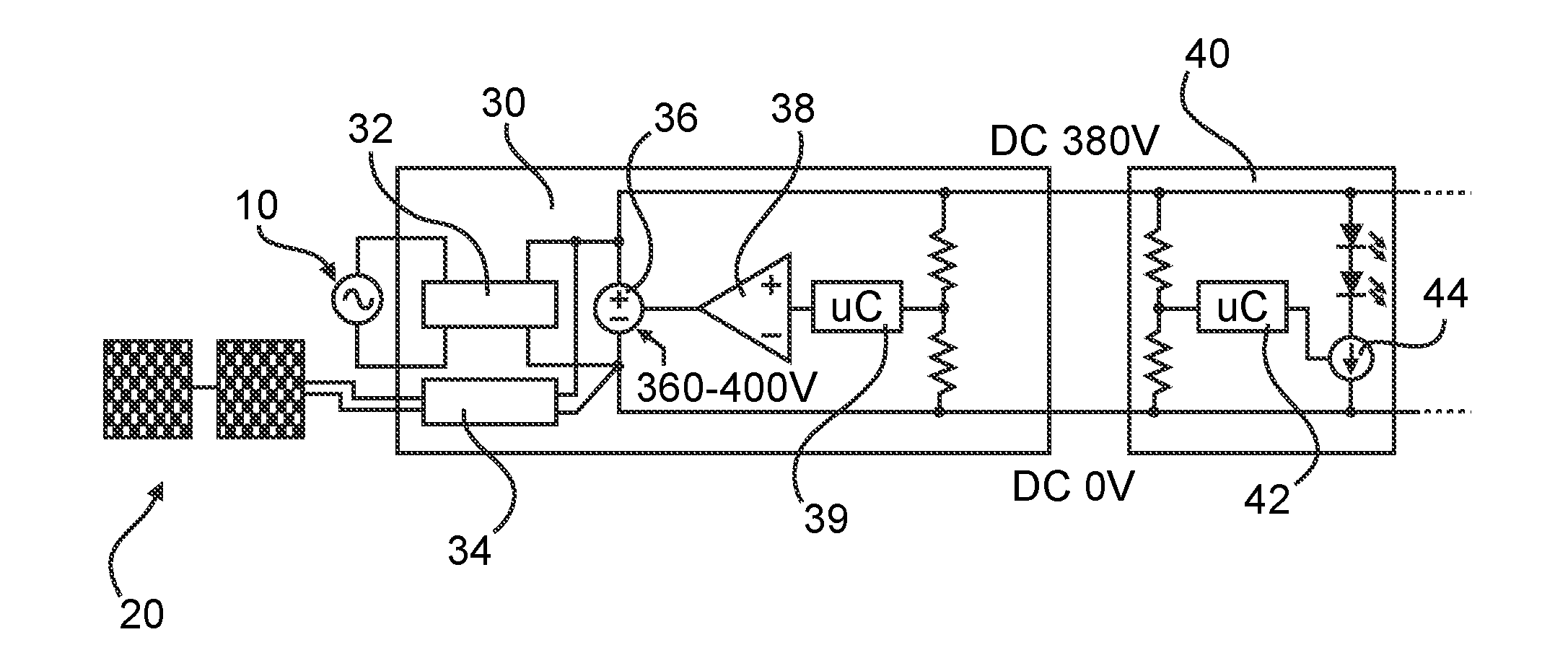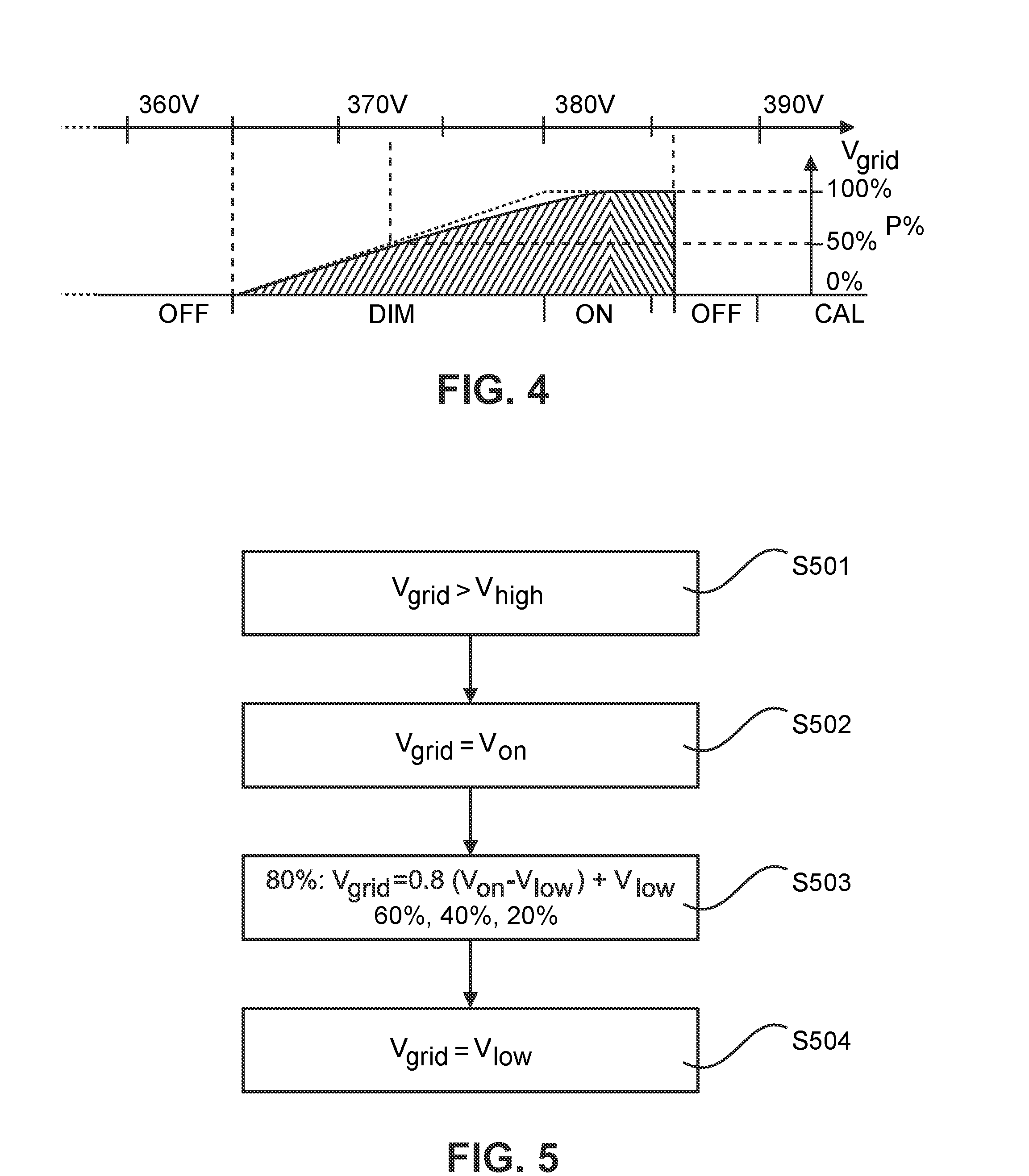Signal-level based control of power grid load systems
- Summary
- Abstract
- Description
- Claims
- Application Information
AI Technical Summary
Benefits of technology
Problems solved by technology
Method used
Image
Examples
first embodiment
[0038]FIG. 2 shows a diagram indicating operating states for various DC grid voltages Vgrid, according to a In this example, a nominal bus voltage of e.g. 380VDC is assumed. The nominal bus voltage can be used in the embodiments to indicate 100% relative output power level P% and can thus be used as reference voltage (Von) which is below the maximum allowed voltage (Vhigh) which can be set to 386VDC in the present example, while the minimum allowed bus voltage can be set to 360VDC. Then, a voltage level of 365 VDC can be used to indicate 0% power or off-level (Vlow). All values between the 100% level and the 0% level may then linearily correspond to the requested dimming value (e.g., 372.5VDC corresponds to 50% dimming (i.e. Vmid). Of course, other non-linear relations may be possible as well, if desired.
[0039]The DC grid controller 30 can now perform on / off control and dimming for an entire group of connected DC luminaire(s) 40 or other loads or devices by suitably changing the DC...
second embodiment
[0045]FIG. 3 shows a diagram indicating operating states for various DC grid voltages, where the voltage level for signaling the optional calibration mode (CAL) is set below the off-voltage threshold (i.e. the minimum allowed bus voltage) rather than above the on-voltage threshold (i.e. minimum allowed bus voltage). Thus, the second predetermined range is located below the minimum allowed bus voltage and any voltage level below the off-voltage threshold will set the DC luminaire 40 into the calibration mode (CAL).
[0046]The control mechanisms according to the above first and second embodiments, as described so far, do not take into account the effect of a voltage drop over the cables of the DC grid. The control range 0% to 100% of the dim level is based on small voltage level variations (e.g. 365V to 380V), which is critical on grids with long cables or large loads. Not correcting for voltage drop could result in unequal dimming levels, or even luminaires turning off when they shoul...
third embodiment
[0047]This detrimental effect is in this context even more complicated because it has a non-linear behavior. As already mentioned above, an LED driver behaves basically as a ‘constant power sink’. Regardless of the input voltage, it will try to consume the same amount of power. A reduced input voltage thus causes an increase in current, which in turn again causes more cable losses and less input voltage until an equilibrium is reached. In a system with multiple consumers (e.g. loads, luminaires or other power consuming devices of the DC grid) it is difficult or impossible to accurately determine what the input voltage for a given device will be at certain load conditions (without performing a measurement). A proposed calibration mechanism according to the following third embodiment can overcome this problem.
[0048]FIG. 4 shows a diagram indicating operating states for various DC grid voltages including a calibration state according to the third embodiment. In FIG. 4, both error curve...
PUM
 Login to View More
Login to View More Abstract
Description
Claims
Application Information
 Login to View More
Login to View More - R&D
- Intellectual Property
- Life Sciences
- Materials
- Tech Scout
- Unparalleled Data Quality
- Higher Quality Content
- 60% Fewer Hallucinations
Browse by: Latest US Patents, China's latest patents, Technical Efficacy Thesaurus, Application Domain, Technology Topic, Popular Technical Reports.
© 2025 PatSnap. All rights reserved.Legal|Privacy policy|Modern Slavery Act Transparency Statement|Sitemap|About US| Contact US: help@patsnap.com



